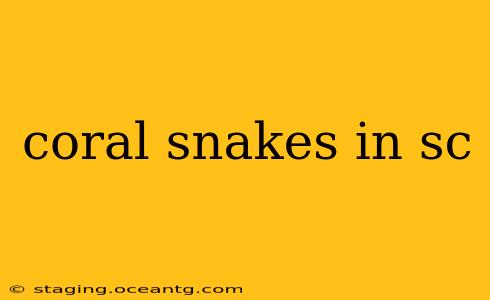South Carolina, with its diverse ecosystems, is home to a fascinating array of wildlife, including venomous snakes. Among these, coral snakes hold a unique place, captivating and concerning in equal measure. This guide delves into the world of coral snakes in South Carolina, addressing common questions and concerns surrounding these striking reptiles.
What types of coral snakes are found in South Carolina?
South Carolina is home to one primary species of coral snake: the Eastern Coral Snake ( Micrurus fulvius). This species is easily recognizable by its distinctive banding pattern, though this is also the source of much confusion and many misidentifications. It's crucial to remember that several harmless snakes mimic the coral snake's coloration.
How can I tell the difference between a coral snake and a mimic?
This is a critical question, as misidentification can have serious consequences. The most common mnemonic device used is: "Red on yellow, kill a fellow; red on black, venom lack." While this rhyme is generally helpful, it's not foolproof and exceptions exist. It's best to avoid handling any snake with a similar banding pattern. If you encounter a snake you suspect is a coral snake, maintain a safe distance and contact a herpetologist or wildlife professional for identification.
Are coral snakes aggressive?
Eastern Coral Snakes are generally not aggressive. They are shy and secretive snakes that primarily use venom to subdue their prey, which mainly consists of lizards and other small reptiles. They are far more likely to flee than to attack, but bites do occasionally occur if the snake is accidentally handled or cornered.
How dangerous is a coral snake bite?
Coral snake venom is highly toxic and neurotoxic, meaning it affects the nervous system. While their venom isn't as potent as some other venomous snakes in the region (like rattlesnakes), it can still be dangerous and requires immediate medical attention. Symptoms can include:
- Drowsiness
- Muscle weakness
- Paralysis
- Respiratory problems
Seek immediate medical care if bitten by a snake you suspect is a coral snake. If possible, try to safely take a picture of the snake (from a distance) for identification purposes.
Where are coral snakes found in South Carolina?
Coral snakes in South Carolina prefer habitats with loose, sandy soil, often found in:
- Longleaf pine forests
- Scrublands
- Coastal areas
They are generally found in the southeastern portion of the state.
What should I do if I see a coral snake?
If you encounter a coral snake, observe it from a safe distance and admire its beauty. Do not attempt to handle or capture it. Remember, even a non-aggressive snake can bite if threatened. Appreciate these creatures from afar and let them continue their vital role in the ecosystem.
What is the best way to prevent coral snake bites?
The best way to prevent coral snake bites is to avoid areas where they are known to live and to exercise caution when working outdoors in areas with suitable habitat. Wear appropriate clothing, including sturdy footwear, and use caution when reaching into piles of debris or under logs. Use a snake-resistant tool for handling objects in areas where coral snakes are known to live.
Remember: This information is for educational purposes only. Always seek professional assistance when dealing with venomous snakes. This guide provides valuable insight into South Carolina’s coral snakes, but it is not a substitute for expert advice. Always prioritize your safety and the well-being of the snake.
